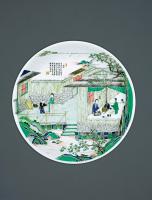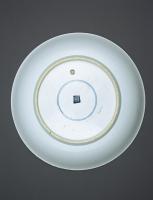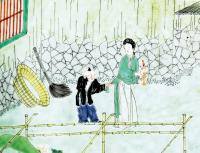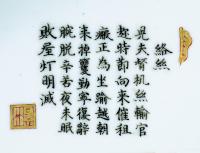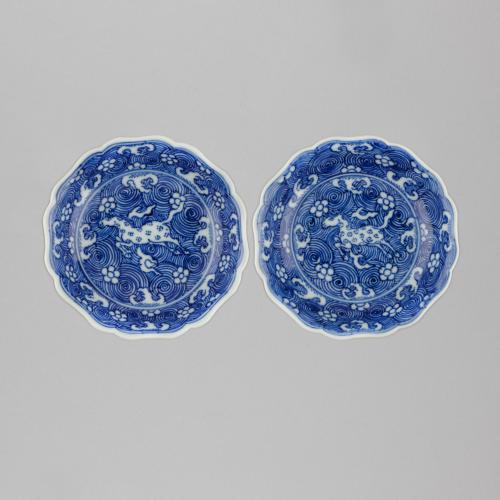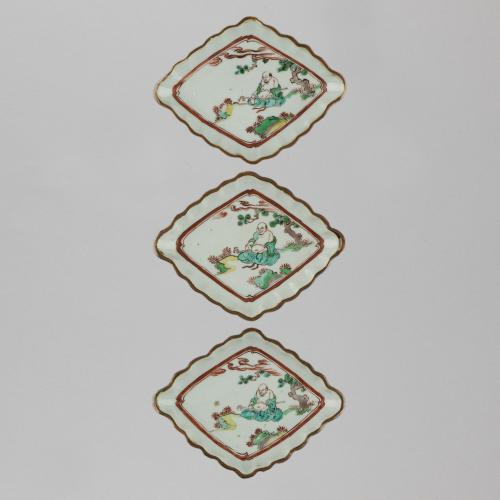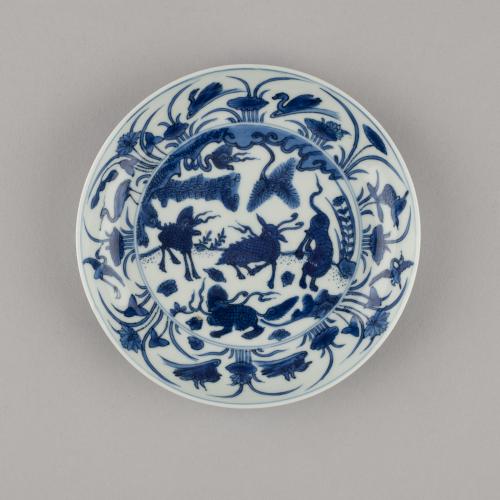
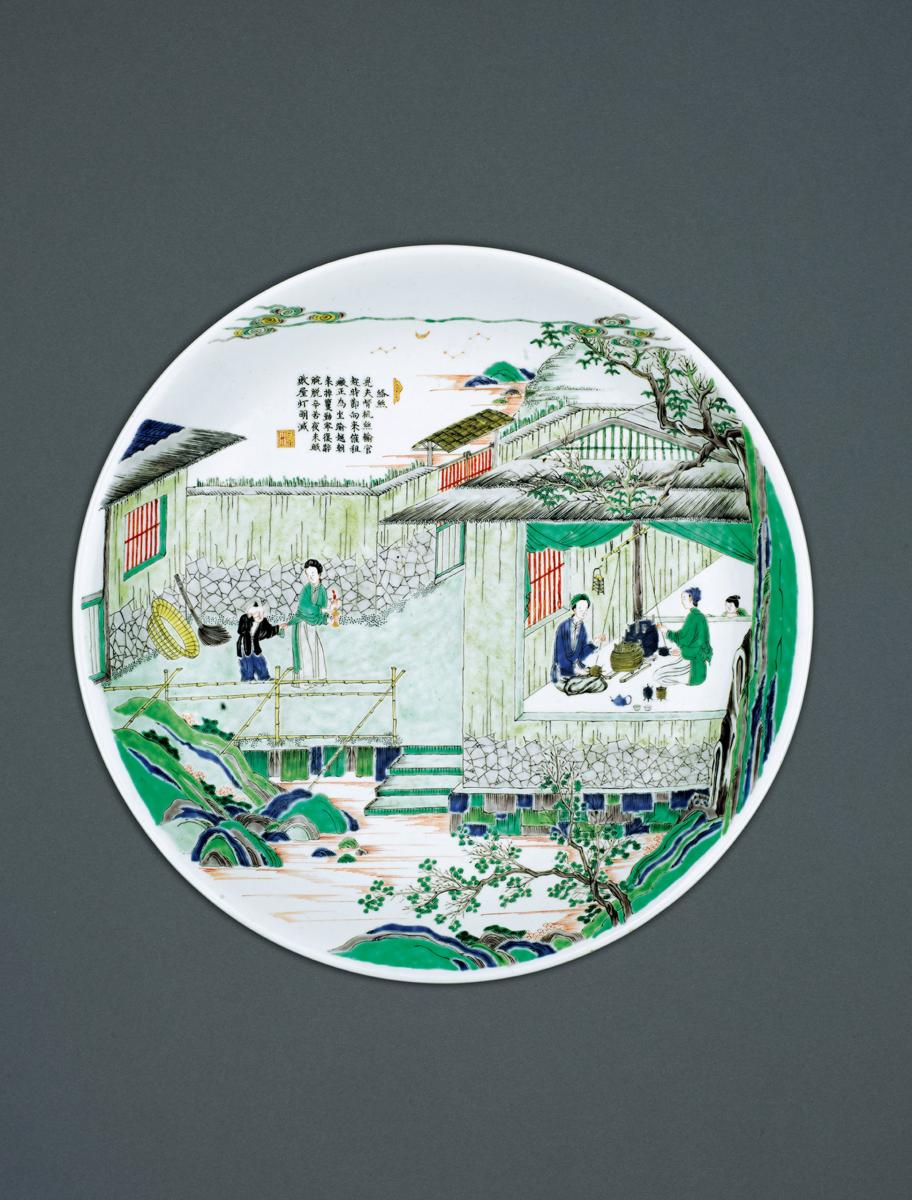
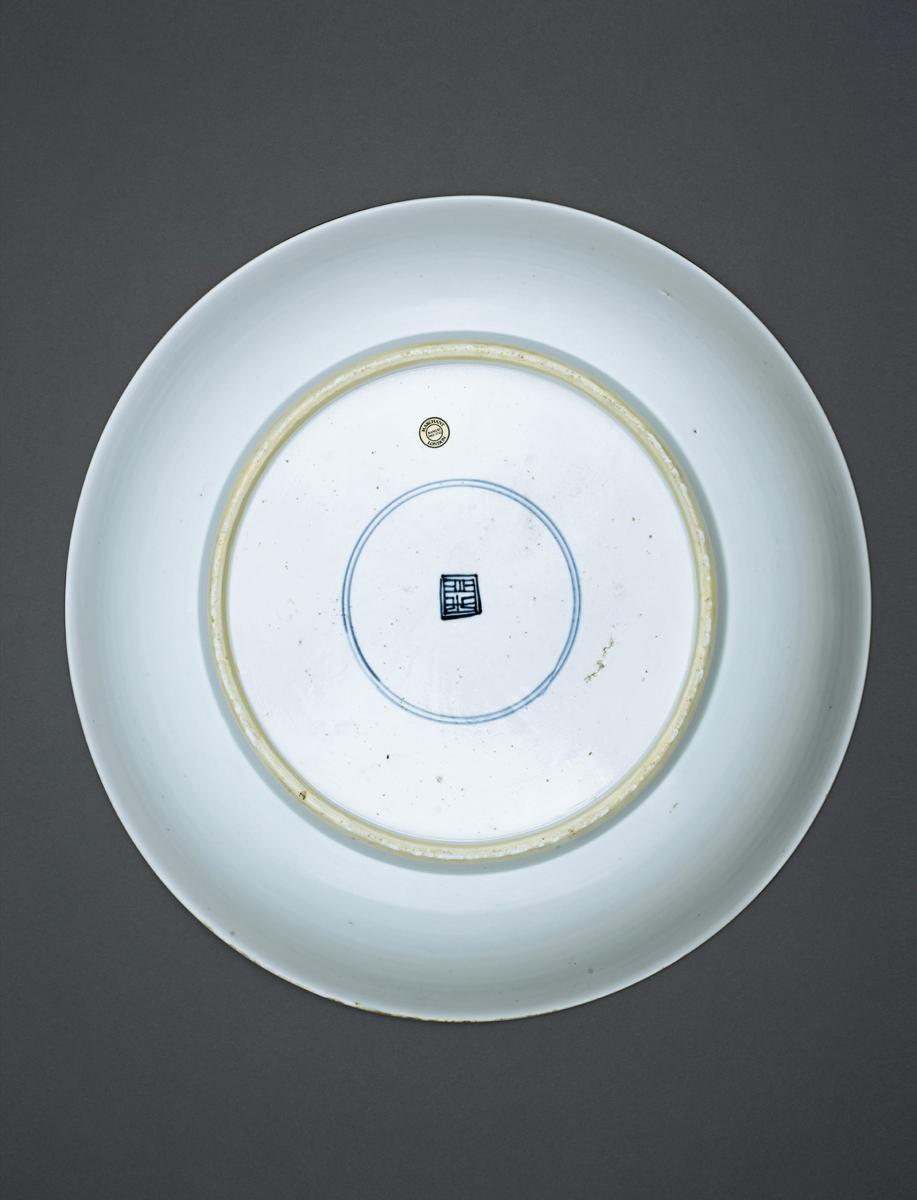
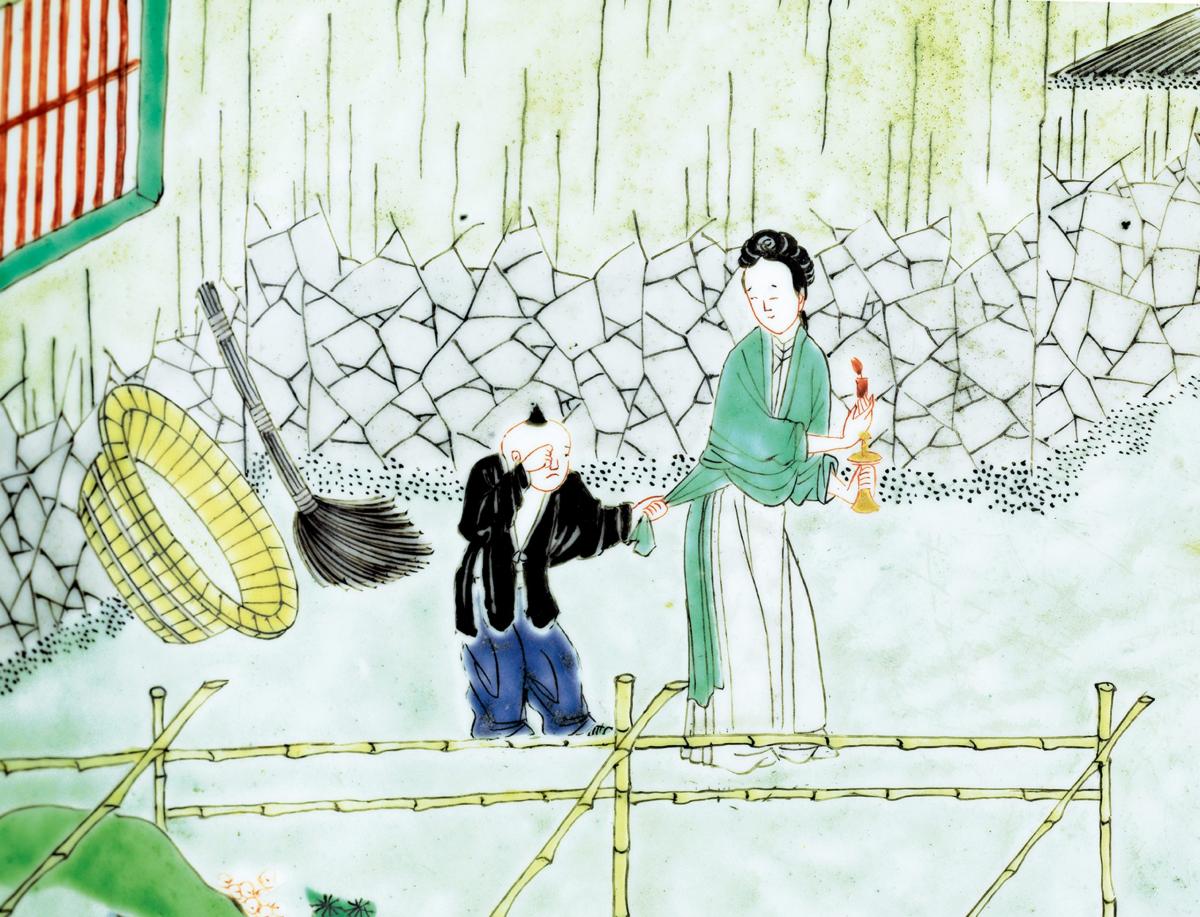
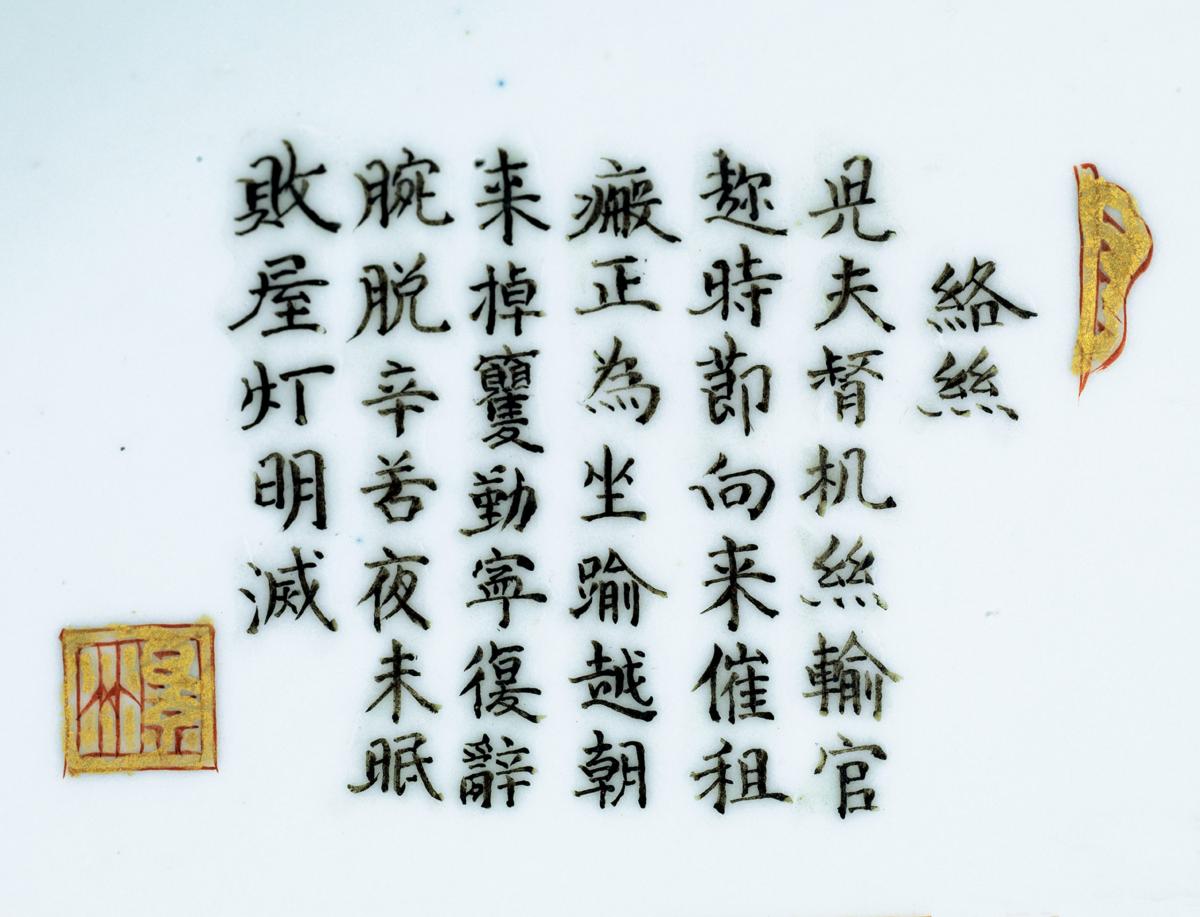
Price on application
This object is eligible for a Certificate of BADA Provenance
The BADA Standard
- Since 1918, BADA has been the leading association for the antiques and fine art trade
- Members are elected for their knowledge, integrity and quality of stock
- Our clients are protected by BADA’s code of conduct
- Our dealers’ membership is reviewed and renewed annually
- Bada.org is a non-profit site: clients deal directly with members and they pay no hidden fees
Chinese porcelain famille verte, large saucer dish with gently flared rim, painted with two seated ladies reeling silk beside a large open window in a covered building with thatched roof with a child watching on, another standing lady holding a candlestick beside a tearful child grabbing her robes while walking on a fenced path all within a walled compound, the base of the walls with crackled brickwork, the foreground with a stream of water, branches and rockwork, all in an evening scene beneath a new moon, stars, ruyi clouds and overhanging wutong branches, a forty-two-character, seven-column poem with an iron-red and gilt two-character seal and leaf mark. The base with a zhi, ‘made’ mark within a double square, all within a double ring in underglaze blue.
15 1/8 inches, 38.5 cm diameter.
Kangxi, circa 1700.
彩御製耕織圖盤 清康熙 製字款 Paul & Helen Bernat 伉儷舊藏
- Formerly in the Paul and Helen Bernat Collection.
- Previously on loan at the Boston Museum of Fine Arts.
- Published by Jan Fontein and Wu Tung in The World’s Great Collections, Oriental Ceramics, Vol. 10, Museum of Fine Arts, Boston, no. 250.
- Sold by Christie’s, New York, in their auction of Fine Chinese Ceramics and Works of Art, Property from the Collection of Paul & Helen Bernat, 2nd December 1993, lot no. 290, pp. 170-171.
- Sold by Marchant, 29th July 1994.
- Formerly in a European private collection.
- Included by Marchant in their 90th Anniversary Exhibition of Qing Porcelain from Private Collections, 2015, no. 8, pp. 18-19.
- Included by Marchant in their exhibition of Kangxi Famille Verte, 2017, no. 16, pp. 44-47.
- The poem is by Lou Chou (1090-1162) and titled Reeling Silk. “My husband checks the silk threads on the reeling machine, we are running against time to turn over the silk to the officials. He still bears the scars from the beating he recently took for failing to meet the deadline to pay rent. Being busy reeling the whole morning, the wrists feel dislocated. We have to keep working hard through the night without sleep, with the lamp flickering in our shabby house.” Seal, Jingzhu (studio or artist).
- Sheila Keppel writes in China in 1700: Kangxi Porcelain at the Taft Museum, that Geng Zhi Tu, the first recorded paintings of the subject of ploughing and weaving in China, were painted during the Northern Song Dynasty (960-1125). Kangxi ordered the court painter, Jiao Bingzhen, to paint a series of pictures on the subject. In 1696, he had the series issued as a woodblock book, cut by Zhu Gui, titled Yu Zhi Geng Zhi Tu, or ‘By Imperial Command: Pictures of Ploughing and Sericulture’. Through publicly associating his reign with the theme, Kangxi was assuring the Chinese that he was conforming to the model of a just and conscientious ruler, thus asserting Manchu legitimacy to his rule. Kangxi made his intension clear in his personally inscribed introduction to the book: ‘I also ordered engraved (woodblock) plates to be made based on the pictures… in order to show them to later generations of the Imperial House, and to officials and commoners. The pictures will enable them to realise that every grain and every piece of cloth are the production of toiling.’ In other words, if those at the court appreciated the effort involved, they would honour and protect those who laboured. In addition, Kangxi personally wrote poems to accompany each page of the book.
- A similar dish from the Musée National des Arts Asiatique, Guimet, Paris is illustrated by Pierre Arizzoli-Clémentel and Bernadette Caille in Kangxi the Emperor of China, an exhibition at The Musée du Chateau des Versailles, 2004, catalogue no. 65, no. 1, p. 141; a further dish of this subject from the collection of the St. Louis Art Museum, no. 268:51 was included by Marchant and illustrated on the front cover in their catalogue of Recent Acquisitions, 2007, no. 33, pp. 62-63; another from the same set of woodblock prints, in the Victoria and Albert Museum, is illustrated by John Ayers and Masahiko Sato in Sekai Toji Zenshu, Ceramic Art of the World, Vol. 15, Ch’ing Dynasty, no. 172, p. 170; and again by John Ayers in Far Eastern Ceramics in The Victoria and Albert Museum, no. 190, collection no. C. 425-1926.
- A rouleau vase with two further scenes of sericulture is illustrated by Anthony du Boulay in The Taft Museum, Its History and Collections, Vol II, Fig. 1, p. 638; another rouleau, with two further scenes is illustrated by Yang Xin in Porcelains in Polychrome and Contrasting Colours, The Complete Collection of Treasures of the Palace Museum, Beijing, Vol. 38, no. 67, pp. 72-73.
- A related dish, with a Kangxi mark, was sold by Christie’s, New York, in their auction of Fine Chinese Ceramics and Works of Art, 18th & 19th March 2009, lot no. 377, pp. 262-263.
- A bowl with agricultural ploughing scenes taken from the same woodblock prints is illustrated Wang Qingzheng in Kangxi Porcelain Wares from the Shanghai Museum Collection, no. 110, pp. 164-165.
Condition report
Excellent, tiny nibblesStock number
M3674The BADA Standard
- Since 1918, BADA has been the leading association for the antiques and fine art trade
- Members are elected for their knowledge, integrity and quality of stock
- Our clients are protected by BADA’s code of conduct
- Our dealers’ membership is reviewed and renewed annually
- Bada.org is a non-profit site: clients deal directly with members and they pay no hidden fees


